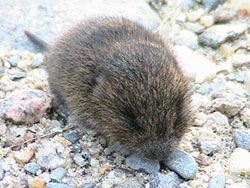In the spring, gardeners may notice struggling trees and shrubs. Drought-like symptoms and die-back may be caused by vole damage. Meadow voles (Microtus pennsylvanicus), common along the Front Range, can girdle woody plants. They especially favor young trees and shrubs, feeding on the phloem tissue directly under the bark. Feeding injury is characterized by eighth inch or smaller gnaw marks. Since these rodents do not hibernate, the damage is done in late winter or early spring when  other food sources are scarce.
other food sources are scarce.
High populations of voles also affect lawns. Voles create networks of tunnels in tall grass, clipping blades at the soil line. They dig under lawns to nest and feed on roots.
Reduce vole populations by mowing tall grass late in the fall, eliminating their habitat. For active vole populations, exclusion, repellents, traps and poison baits are effective. Exclude voles with wire or mesh surrounding trees or repel them with thiram or hot sauce (capsaicin) sprays. Mousetraps are effective for small populations.
For more information, see the following Planttalk Colorado™ video(s).



